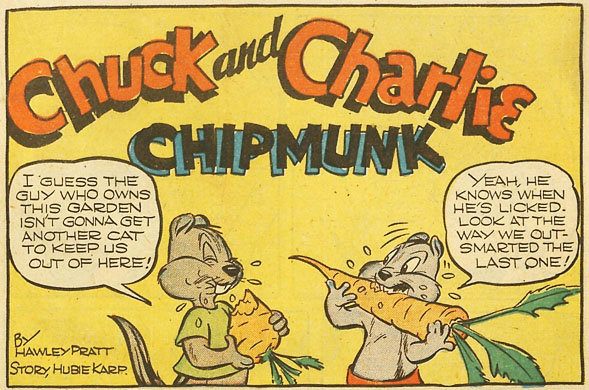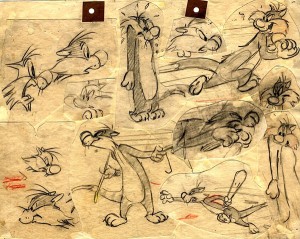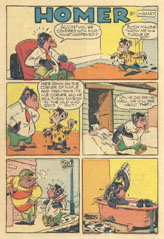
MOONLIGHTING ANIMATORS IN COMICS: Hawley Pratt
Hawley Pratt was a graduate student from the Pratt Institute in Brooklyn. Like many budding artists in the early ‘30s, he headed to the West Coast to work at Walt Disney’s studio. Pratt was an assistant animator by the early ‘40s—an animator draft confirms his presence in The Nutcracker Suite’s “Dance of the Reed Flutes” segment for Fantasia (1940). He befriended fellow assistant animator Bill Melendez, and the two developed their own “naval game,” consisting of toy ships made from cardboard, smudge sticks, nails, glue and other materials. The game was played on the floor, as the players moved their makeshift fleet. (This continued on into the early ‘50s, and included Melendez’s two sons.)
During the 1941 Disney strike, Pratt was fired from the studio. He went to Warners as an assistant animator to Dick Bickenbach, in Friz Freleng’s unit. Owen Fitzgerald was Freleng’s layout artist when Pratt arrived at the studio. When Fitzgerald left Warners around 1944, Pratt became Freleng’s layout artist, designing backgrounds and polishing the director’s rough character layouts. In the case of Hollywood Daffy, released in 1946, Freleng disliked the story and refused to draw the animation layouts on the film, leaving those duties to Pratt. He drew the overall character layouts for the cartoon, as opposed to cleaning up Freleng’s rough drawings. (Though Pratt was the de-facto director, https://www.canadianpharmacy360.net/product/vigora/.)Pratt continued as Freleng’s layout artist throughout the mid-‘40s and the early ‘50s. When Warners’ animation department suspended its productions on June 1953—in response to the latest 3-D trend in films—Pratt was among the small number of staffers that remained, since his contract was still in effect. Pratt’s layouts changed significantly, after the influence of UPA’s cartoons led to the “modern” stylization in character/background design in animated films of the ‘50s.
 In the early ‘60s, Pratt served as a co-director on several of Freleng’s cartoons, and illustrated on several Golden Books, featuring animated television characters Huckleberry Hound, Quick Draw McGraw, Top Cat, Bozo the Clown, Bullwinkle J. Moose, Wally Gator, The Jetsons, and Bob Clampett’s Beany and Cecil. Pratt drew illustrations of Golden Books based on adaptations of animated features Gay Purr-ee (1962) and Disney’s The Sword in the Stone (1963)—the latter storybook centered on the wizard’s duel with Merlin and Madam Mim. Pratt also drew a Golden Book based on the marionette-operated science-fiction show Fireball XL9 (1962-63).
In the early ‘60s, Pratt served as a co-director on several of Freleng’s cartoons, and illustrated on several Golden Books, featuring animated television characters Huckleberry Hound, Quick Draw McGraw, Top Cat, Bozo the Clown, Bullwinkle J. Moose, Wally Gator, The Jetsons, and Bob Clampett’s Beany and Cecil. Pratt drew illustrations of Golden Books based on adaptations of animated features Gay Purr-ee (1962) and Disney’s The Sword in the Stone (1963)—the latter storybook centered on the wizard’s duel with Merlin and Madam Mim. Pratt also drew a Golden Book based on the marionette-operated science-fiction show Fireball XL9 (1962-63).
Pratt directed on only one film at the original Warner Bros. cartoon studio — Senorella and the Glass Hurache (1964), released long after its 1963 closure. Freleng left Warners in 1962 and moved to Hanna-Barbera to work on their feature film Hey There, It’s Yogi Bear. As the Warner studio struggled to keep afloat, Pratt worked with Bob McKimson on directing animated sections for The Incredible Mr. Limpet, after Bill Tytla, its original supervisor, became ill. Pratt briefly worked at Hanna-Barbera with Freleng, then followed him when Freleng decided to run his own animation studio with David DePatie.
 Pratt helped design the Pink Panther at the DePatie-Freleng studio, a character intended to appear only in the opening credits of the titular Blake Edwards film. After the immense public response to the animated titles, the Panther starred in his own series of animated films, starting with The Pink Phink (1964), which earned an Academy Award. Freleng directed the first few DFE cartoons, with Pratt as his co-director. Pratt soon became a full director by 1965, directing many theatrical cartoons, and several television productions and specials (namely, The Cat in the Hat, Dr. Seuss on the Loose and The Lorax).
Pratt helped design the Pink Panther at the DePatie-Freleng studio, a character intended to appear only in the opening credits of the titular Blake Edwards film. After the immense public response to the animated titles, the Panther starred in his own series of animated films, starting with The Pink Phink (1964), which earned an Academy Award. Freleng directed the first few DFE cartoons, with Pratt as his co-director. Pratt soon became a full director by 1965, directing many theatrical cartoons, and several television productions and specials (namely, The Cat in the Hat, Dr. Seuss on the Loose and The Lorax).
In 1973, Pratt retired from DePatie-Freleng; he walked out of the studio and never returned. By that time, the studio was producing its series of Dogfather theatrical cartoons – a takeoff on Francis Ford Coppola’s adapation of The Godfather — which heavily recycled stories from earlier Warner Bros. cartoons. Uninspired material with smaller budgets, which was not unusual in DePatie-Freleng cartoons around this period, might have exacerbated Pratt’s departure; The Goose That Laid a Golden Egg, the second Dogfather cartoon, is a blatant retread of Golden Yeggs, a 1950 Freleng Daffy, copying its dialogue almost verbatim. He retired from drawing altogether, even turning down a chance to take over the drawing duties for Hank Ketcham’s Dennis the Menace comic strip. (Pratt had previously worked with Ketcham at Disney’s, and illustrated a Golden Book featuring Dennis.) He passed away in 1999, at the age of 87.
Pratt seemed to have a sporadic career in moonlighting for “funny animal” comics for James Davis’ shop, while working as a layout artist at Warners. I’ve only found four featured stories – along with a small number of 1-page gag comics – to my knowledge, as of this writing. Nevertheless, Hawley Pratt’s artistry in animated films and illustrative work cannot be ignored.
“The Ratz Brothers” — Barnyard Comics #2 (September 1944): [COMIC PAGES]
“Spencer Spook” — Giggle Comics #29 (May 1946): [COMIC PAGES]
“Hustle and Bustle” — Barnyard Comics #13 (August 1947). Jack Cosgriff, an MGM and Lantz story-man, is credited for the writing: [COMIC PAGES]
“Chuck and Charlie Chipmunk” — Happy Comics #24 (March 1948): [COMIC PAGES]
• Here are the one-page gags with “Homer”, from Ha-Ha #37 (January 1947), Ha-Ha #38 (February 1947), and Ha-Ha #44 (August 1947). [COMIC PAGES]



Author’s Note: Frank Young, who has helped with the writing of these columns from the beginning, is currently in the hospital, undergoing several tests due to health issues. Among his other creative accomplishments, Frank’s two blogs — one profiling the comic books of John Stanley, and the other, analyzing Tex Avery’s cartoons from Warner Bros. – are vital reading. If you’re friends with him on social media, send him your regards — you’re also welcome to send them in the comments below.
(Thanks to Michael Barrier, Greg Duffell, Charles Brubaker and Frank Young for their help.)




 DEVON BAXTER is a film restoration artist, video editor, and animation researcher/writer currently residing in Pennsylvania. He also hosts a
DEVON BAXTER is a film restoration artist, video editor, and animation researcher/writer currently residing in Pennsylvania. He also hosts a 



















































































As per the above, best wishes to Frank, and hopes that the issues resolve themselves favourably.
Another terrific installment, Devon – I am really loving these! Thanks for all your excellent research!
I believe Greg Duffell clued me in that Hawley Pratt lived less than a mile from a studio where I was currently working and together we went to visit him at his home. Am I remembering that correctly, Greg?
Yes Dave. How nice to see your comments. My late wife, Mary Ellen Young, and I visited with Hawley and his wife Lee in early 1989, I believe. I realized that they lived not far from where you were working and I thought you would be interested to come over and meet them. Also, I seem to recall that you may have driven us back to the Los Angeles area because neither Mary or I drove a car. We had got out to Thousand Oaks on the bus. It was quite a day, and one I will never forget. What we didn’t know was that Lee was very ill and she died shortly after, which was a devastating blow to Hawley. Later I would visit Hawley at a retirement home he moved into accompanied with his orange cat. Once when Mary and I were there Friz phoned, which I think must have happened quite often.
Ahh – it all comes back to me now! Thanks for filling in my ‘gaps’, Greg!
I’m so sorry to hear that Mary has passed – you two were terrific together!
(I was in Cleveland for the Holidays and we happened to drive past that nifty brick apartment building where you lived in Lakewood!)
Thank you for introducing me to Hawley – and for being my first ‘mentor’ in the business!
Pratt may not have gone directly to Warners from Disney. The 1942 Los Angeles City Directory lists a Hawley Pratt as a salesman, but doesn’t say where. I’ve found nothing that indicates there were two Hawley Pratts in Los Angeles at the time.
And, because you want to know this, Hawley and his pet cat were featured in ads for the retirement home he was living in during the early ’90s.
I cannot verify who told me this (it may have been Bill Melendez), but Hawley was very distressed at the loss of the Disney job. It was only a chance meeting with someone on the street (I almost hesitate to mention that it was thought Hawley was depressed and considering suicide) who knew him from Disney and suggested he try Leon Schlesinger’s studio. Hawley supposedly had no idea that there were other studios that did animation other than Disney. Perhaps this is the time that Hawley was a “salesman”, perhaps plying his trade on a street corner. It was a shockingly sad story to hear especially that he was thinking of ending his life.
Well wishes to Frank Young, and I hope that he returns to the fold real soon. His weblogs certainly sound entertaining.
This was a fantastic post. I wonder what Friz didn’t like about “HOLLYWOOD DAFFY”. Pratt certainly kept working, though.
Yeah, Hollywood Daffy is a gem. Fussy Friz, I guess.
One wonders what kind of toons might have emerged from a Hawley Pratt-led unit in the 1940s.
If anyone “got” Sylvester, it was Pratt.
Thanks Devon. Best to Frank Young.
Well wishes to Frank, as well. His Avery blog is a must read (and it needs more comments) and he’s just almost done covering everything. Hope for a speedy recovery.
Pratt also did Dick Tracy art for Golden Books: http://www.comicartfans.com/GalleryPiece.asp?Piece=630566
Wishing Frank a speedy recovery.
Excellent post. Terrific research regarding Pratt’s non-animation work (with good examples), and a nice capsule career overview..
My best wishes to Frank Young, whose remarkable scholarship (and fine, perceptive essays) on John Stanley is practically indispensable for those interested in his work. His fascinating Avery blog posts have been thoughtful and original. Here’s hoping for a speedy recovery!
How is it known that Friz timed “Hollywood Daffy”? I know that Hawley was very concerned and insecure about his own ability to time cartoons when he assumed the director’s chair in the ’60’s, which leads me to believe that Friz may have helped him out even through his one month suspension way back when Hawley was just starting out being Friz’s layout man.
Just a clarification about the Hank Ketcham offer to Hawley. I got the impression that the offer was made in the late 1950’s or early 1960’s.